Have you ever wondered about birds that eat wasps? While wasps may be feared by many, several bird species fearlessly include these stinging creatures in their diet. Prepare to be amazed as we explore six remarkable birds that not only consume wasps but do so with style and grace.
But wait, isn’t it dangerous for birds to eat wasps? How do they manage to do it without getting stung? In this article, we’ll uncover the secrets behind these avian insect hunters and provide breathtaking photos that capture them in action. Get ready to witness nature’s fascinating predators as they eliminate their buzzing foes.
Here are the main points:
- Several bird species include wasps in their diet.
- These birds exhibit remarkable hunting skills and fearlessly prey on wasps.
- Photos of these birds in action showcase their beauty and the intensity of their hunting.
- Understanding how birds evade wasp stings sheds light on their strategies.
- By appreciating and supporting these bird species, we contribute to natural pest control.
Black-capped Chickadee: A Small but Fearless Predator
The black-capped chickadee is a small bird that fearlessly takes on insects, including wasps. With its distinctive markings and bold behavior, this bird is a remarkable predator in the avian world.
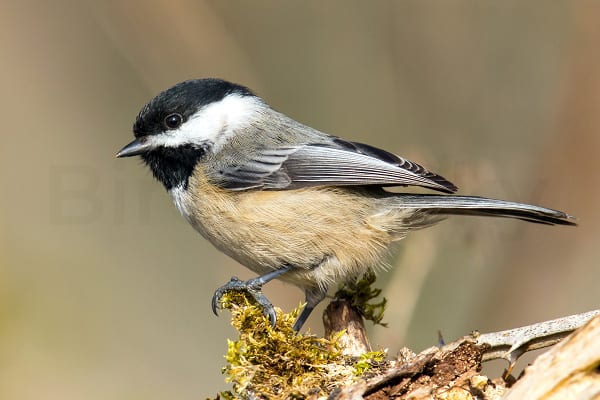
One of the most recognizable features of the black-capped chickadee is its black cap and bib, contrasting with its white cheeks and belly. This charming bird is about 5 to 6 inches in length, making it easy to spot amidst trees and shrubs.
When it comes to hunting wasps, the black-capped chickadee shows no hesitation. It fearlessly forages through foliage, catching insects on the wing or plucking them off leaves. Its nimble flight and agile movements allow it to swiftly navigate its surroundings in search of prey.
The black-capped chickadee’s diet consists of various insects, including wasps. It possesses a unique adaptation that enables it to eat certain insects without being stung. The bird has a specialized technique to extract the venomous sting from its prey before consuming it, ensuring a safe meal.
Here is a photo of the black-capped chickadee, enabling you to visualize this small but mighty predator:
| Black-capped Chickadee | |
|---|---|
 | Scientific name: Poecile atricapillus Size: 5-6 inches Distinctive features: Black cap and bib, white cheeks and belly Diet: Insects, including wasps |
Observing the black-capped chickadee in action, you’ll appreciate its fearlessness and efficiency in hunting wasps. Keep an eye out for this remarkable bird the next time you venture into nature.
Northern Mockingbird: A Versatile Insect Eater
The northern mockingbird is a highly adaptable bird known for its impressive insect-eating abilities. This species has earned a reputation as a fantastic wasp hunter, among other insects. Let’s explore some of the unique characteristics and habits that make the northern mockingbird such a remarkable bird.
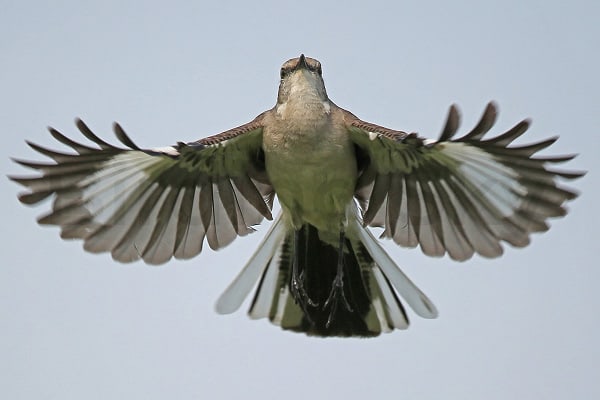
Distinctive Features and Behavior
The northern mockingbird is a medium-sized bird with a grayish-brown plumage, white wing patches, and a long tail. Its distinctive feature is its ability to mimic the songs of other birds, earning it the name “mockingbird.” This skill helps it attract mates and establish territory.
Not only does the northern mockingbird have a beautiful voice, but it also showcases its agility and versatility when hunting insects, including wasps. Its long bill allows it to snatch flying insects out of mid-air, while its quick reflexes help it evade stingers.
| Distinctive Features of the Northern Mockingbird |
|---|
| Grayish-brown plumage |
| White wing patches |
| Long tail |
| Mimics the songs of other birds |
| Agile and versatile hunter |
A Diet of Variety
The northern mockingbird has a diverse diet that includes not only wasps but also other insects, fruits, and berries. This adaptability allows it to survive in different habitats, from grasslands to forests and even urban areas.
Their insect-eating habits, including feeding on wasps, make them valuable allies in controlling pest populations. By consuming these stinging insects, mockingbirds serve as natural pest control agents that help maintain balance in the ecosystem.
Photo of the Northern Mockingbird
Insert a captivating photo of a northern mockingbird in action, showcasing its distinct features and hunting prowess.
Now that we’ve explored the remarkable characteristics and feeding habits of the northern mockingbird, let’s move on to the next bird species that also consumes wasps: the common blackbird.
Common Blackbird: A Wasp-Eating Songbird
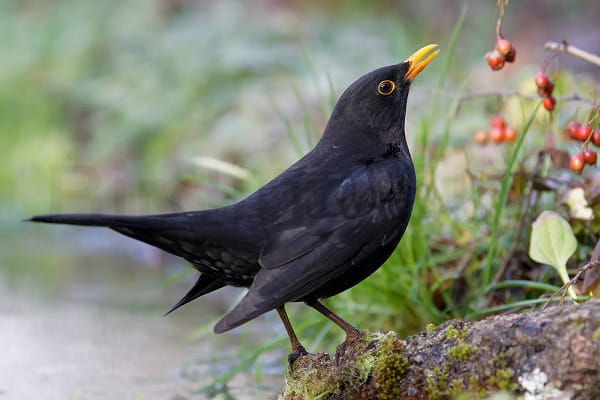
The common blackbird, also known as the Eurasian blackbird, is a fascinating songbird that has a diverse diet, including wasps. This bird’s ability to consume these stinging insects is not only impressive but also beneficial for pest control in the environment.
Common blackbirds are known for their beautiful black plumage and melodious songs. They are found in various habitats across Europe, Asia, and North Africa. While they primarily feed on fruits, earthworms, and insects, their inclusion of wasps in their diet highlights their adaptability and resourcefulness.
These songbirds are skilled hunters and foragers, using their sharp beaks to catch and consume a wide range of insects, including wasps. They are agile in flight and can swiftly capture these buzzing pests in mid-air, displaying their remarkable hunting capabilities.
Interestingly, common blackbirds have also been observed using active hunting techniques, such as flipping over leaves and stones to uncover hidden prey, including wasps and other insects. Their keen eyesight and attention to detail enable them to locate and target these small arthropods with precision.
Common blackbirds are not only adept at consuming wasps but also play a crucial role in maintaining a healthy ecosystem. By controlling the population of these stinging pests, they contribute to the balance of nature and the overall well-being of their surrounding environment.
Here are some interesting facts about the common blackbird:
- Adult males have a distinct yellow eye-ring, while females have a brown eye ring.
- They build cup-shaped nests using a combination of mud, grass, and twigs.
- Common blackbirds are known for their rich, melodic songs, which they use to establish territories and attract mates.
- They have a lifespan of 2-5 years in the wild.
| Common Blackbird | Photo |
|---|---|
| The common blackbird (Turdus merula) is a songbird species | [Insert photo of a common blackbird eating a wasp] |
With their charming appearance, melodious songs, and valuable pest control abilities, common blackbirds are truly remarkable creatures. Appreciate their presence in your surroundings and enjoy the benefits they bring as nature’s little wasp-eating songbirds.
Blue Jay: A Bold Hunter of Wasps
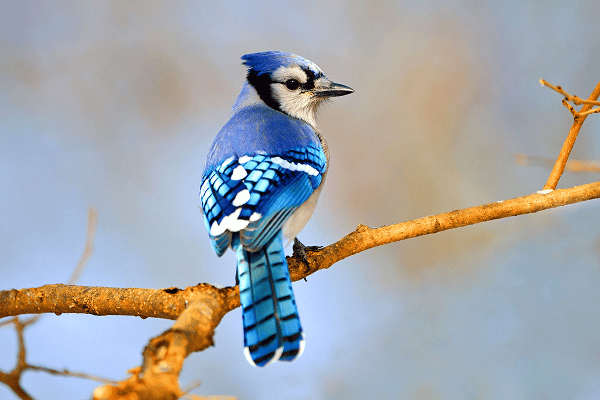
With its vibrant blue feathers and assertive nature, the blue jay is a conspicuous bird that feeds on a range of insects, including wasps. Found throughout North America, this avian predator is known for its unparalleled hunting skills and striking appearance.
Behavior and Adaptations
The blue jay is an opportunistic feeder, consuming a wide variety of food sources. While their diet mainly consists of nuts, seeds, and berries, they are not averse to including insects in their meals. This includes wasps, which they catch in mid-air or pluck from the ground.
These birds have strong beaks that allow them to break open the hard exoskeletons of insects like wasps. Their aggressive and confident nature makes them unafraid of their stinging prey. Blue jays have also been observed mimicking the calls of hawks and other predators to scare away other birds and claim food sources for themselves.
Appearance
Blue jays are recognized for their stunning blue plumage, which covers most of their body. They have white undersides and black facial markings, creating a striking contrast against their vibrant feathers. Their crested heads and sturdy bills give them a distinctive silhouette.
“The blue jay’s vibrant colors and bold personality make it a favorite among birdwatchers and nature enthusiasts. Its ability to fearlessly target wasps adds to its allure and showcases its adaptability as a predator.” – Birdwatching Monthly
So, keep an eye out for the blue jay during your next outdoor adventure. You might just witness this bold hunter in action as it fearlessly takes on wasps and other insects.
With its vibrant blue feathers and confident demeanor, the blue jay is a true marvel of nature. Be captivated by its beauty and admire its hunting prowess.
Common Starling: A Pathfinder in Pest Control
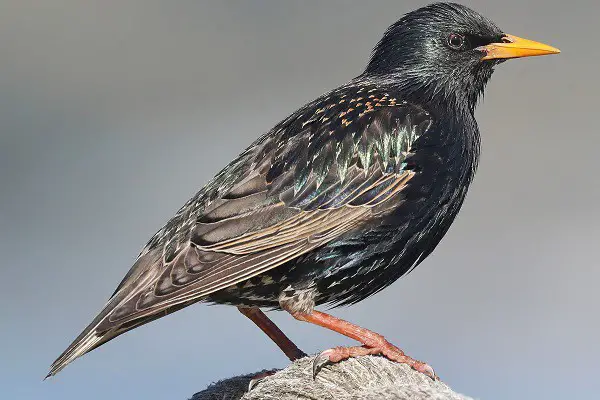
The common starling is a remarkable bird that plays a crucial role in pest control, exhibiting a particular appetite for wasps. These birds have honed their skills and developed unique strategies to efficiently prey on wasps, helping to keep their populations in check.
One of the starling’s notable hunting techniques is its ability to create a “rolling swarm,” where they gather in large numbers and perform synchronized aerial movements. This mesmerizing display not only confuses and disrupts the wasps but also allows the starlings to target and capture individual wasps with ease.
Common starlings are highly adaptable and can thrive in a variety of habitats, taking advantage of urban spaces, agricultural areas, and natural environments. They are known to nest in tree hollows, crevices, and even man-made structures.
To give you a closer look at these remarkable birds and their role in pest control, here is an eye-catching photo of a common starling:
“The common starling’s prowess in hunting wasps is a testament to their adaptability and intelligence. Their collective movements when targeting wasps are truly awe-inspiring.” – Birdwatcher, Linda Thompson
| Bird Name | Diet | Habitat | Conservation Status |
|---|---|---|---|
| Common Starling | Insects, including wasps | Various habitats including urban, agricultural, and natural | Least Concern |
As depicted in the table above, the common starling’s diet includes wasps, making them a valuable ally in controlling pest populations. Additionally, their adaptability and widespread distribution contribute to their least concern conservation status.
Next, we’ll delve into the fascinating world of the yellow-billed magpie, a specialist in wasp predation. Stay tuned to discover the unique characteristics of this visually striking bird.
Yellow-billed Magpie: A Wasp-Eating Specialist

The yellow-billed magpie is a visually striking bird that holds a unique place among the wasp-eating avian species. With its bold black and white plumage and vibrant yellow beak, this Corvidae bird stands out in any environment. Found exclusively in California’s Central Valley and nearby foothills, it is a geographically restricted but fascinating species.
What sets the yellow-billed magpie apart from other wasp-eating birds is its specialization in hunting social wasps, primarily paper wasps. These birds have developed impressive strategies to tackle this particular prey. They’ve mastered the art of defensiveness, with an ability to avoid painful stings while efficiently nabbing wasps in mid-air.
The yellow-billed magpie’s long, slender bill is essential for its wasp-hunting expertise. Its narrow shape allows for precise strikes, enabling the bird to snatch wasps and avoid direct contact with their venomous stingers. This specialized beak is truly a marvel of evolution, perfectly suited for this unique hunting technique.
In addition to their foraging skills, yellow-billed magpies are highly social birds, maintaining close-knit family groups that work together to provide for their offspring and defend their territory. They build intricate nests made of twigs and branches, creating safe havens for their young. These nests are often located high up in trees, providing a strategic vantage point for hunting wasps and other insects.
Seeing a yellow-billed magpie in action is a sight to behold. Its elegant and precise movements, combined with its fearless demeanor, make it a true marvel of nature and a testament to the extraordinary diversity of avian species.
| Yellow-billed Magpie | Key Characteristics |
|---|---|
| Habitat | California’s Central Valley and nearby foothills |
| Diet | Specializes in hunting social wasps, primarily paper wasps |
| Appearance | Distinct black and white plumage with a vibrant yellow bill |
| Behavior | Social birds, nesting in trees and working together to provide for their offspring |
Summary of 6 Birds That Eat Wasps
In this section, we will provide a concise summary of the six bird species that have a diet that includes wasps. These avian insect hunters play an important role in maintaining ecological balance and controlling pest populations.
- Black-capped Chickadee: A small bird known for its fearlessness when it comes to hunting insects, including wasps. This bird can be identified by its black cap and throat, and frequent visits to bird feeders.
- Northern Mockingbird: A versatile bird that consumes a wide variety of insects, including wasps. With its distinctive gray plumage and melodious song, the Northern Mockingbird is a common sight in suburban areas.
- Common Blackbird: Also known as the Eurasian blackbird, this songbird has a diverse diet that includes wasps. Look for its all-black plumage and distinctive yellow eye ring.
- Blue Jay: With its vibrant blue feathers and bold nature, the Blue Jay is an eye-catching bird that hunts various insects, including wasps. Its loud calls and crest make it easily recognizable.
- Common Starling: Known for its impressive ability to control pest populations, the Common Starling also preys on wasps. Look for its iridescent plumage and distinctive speckled appearance.
- Yellow-billed Magpie: This visually striking bird has a special affinity for wasps. Its striking black and white plumage, coupled with its yellow bill, makes it stand out in any natural setting.
These birds are beautiful and fascinating creatures that not only add to the diversity of our ecosystems but also provide valuable pest control services. Encouraging their presence in your environment can help maintain a balanced ecosystem and reduce the impact of wasp populations.
Enjoying Nature’s Pest Control
Having birds that eat wasps around your home can bring numerous benefits, beyond just enjoying their impressive hunting abilities. These avian insect hunters play a crucial role in natural pest control, helping to keep the population of pesky wasps in check. By appreciating and supporting these birds, you can create a balanced ecosystem in your surroundings.
The Benefits of Birds That Eat Wasps
When you have birds that eat wasps in your area, you can experience several advantages:
- Reduced Pest Population: Birds that eat wasps actively hunt and consume these insects, causing a decline in their numbers. This can help minimize the annoyance and potential harm caused by wasps, creating a safer environment for both humans and other wildlife.
- Natural Pest Control: Instead of relying on chemical pesticides, encouraging birds that eat wasps offers a more sustainable and environmentally friendly approach to pest management. These birds naturally control the population of wasps without introducing harmful chemicals into the ecosystem.
- Biodiversity Promotion: Birds that eat wasps are part of a diverse ecosystem and contribute to the overall balance of species. Their presence supports biodiversity by maintaining a healthy predator-prey dynamic.
- Enjoyment of Nature: Observing birds that eat wasps can be a fascinating and educational experience. Their unique hunting strategies and behaviors showcase the beauty of nature up close, providing an opportunity for personal enjoyment and connection with the natural world.
Supporting Avian Insect Hunters
If you want to attract and support birds that eat wasps, consider implementing the following strategies:
- Provide Food Sources: Set up bird feeders with appropriate food, such as mealworms, fruits, or birdseed mixes that include insects. This will help attract a variety of insect-eating birds, including those that prey on wasps.
- Create Suitable Habitats: Enhance your outdoor space by planting native trees, shrubs, and flowers that offer shelter and nesting sites for birds. Providing water sources, such as birdbaths or ponds, can also attract insect-hunting birds.
- Avoid Chemicals: Minimize or eliminate the use of pesticides, as they can harm birds and disrupt the natural food chain. Opt for organic gardening methods and rely on birds to control pest populations naturally.
- Keep Cats Indoors: Cats are natural hunters and can pose a threat to birds. By keeping your cats indoors, you can help protect the bird populations in your area.
By taking these steps, you can create an inviting habitat for birds that eat wasps and contribute to a healthier, more harmonious ecosystem.
| Bird Species | Scientific Name | Common Diet |
|---|---|---|
| Black-capped Chickadee | Poecile atricapillus | Wasps, beetles, caterpillars, and other insects |
| Northern Mockingbird | Mimus polyglottos | Wasps, bees, ants, grasshoppers, and other insects |
| Common Blackbird | Turdus merula | Wasps, beetles, spiders, earthworms, and fruits |
| Blue Jay | Cyanocitta cristata | Wasps, beetles, grasshoppers, and other insects |
| Common Starling | Sturnus vulgaris | Wasps, beetles, flies, and other insects |
| Yellow-billed Magpie | Pica nuttalli | Wasps, bees, beetles, and other insects |
Protecting and Attracting Wasp-Eating Birds
Creating a welcoming environment for birds that eat wasps not only benefits your backyard ecosystem but also helps control pesky wasp populations naturally. By providing suitable habitats and enticing food sources, you can attract these helpful avian predators to your yard. Here are some tips and strategies:
- Plant Native Trees and Shrubs: Native plants attract a variety of insects, including wasps, which in turn attract wasp-eating birds. Choose species that offer food and shelter for these birds, such as fruit-bearing trees like cherry or serviceberry.
- Install Birdhouses and Nesting Platforms: Wasp-eating birds, like the black-capped chickadee and northern mockingbird, require suitable nesting sites. Install birdhouses or platforms designed specifically for these species to provide them with a safe place to raise their young.
- Create Natural Cover: Birds need places to hide and rest. Plant dense shrubs and bushes to create natural cover and sheltered areas within your yard. This will attract birds that eat wasps and provide them with a safe haven.
- Provide Water Sources: Birds need water for drinking and bathing. Install a bird bath or a shallow pond to attract these avian predators. Keep the water source clean and refreshed regularly.
- Offer Wasp-Friendly Food Sources: In addition to their wasp diet, these birds also require other food sources. Install bird feeders that offer a variety of seeds, nuts, and suet to attract birds to your yard.
Remember, creating a haven for wasp-eating birds requires patience and time. Once you’ve implemented these strategies, be patient and allow the birds to discover your yard. With persistence, you can develop a thriving habitat that attracts and supports these beneficial avian insect hunters.
Capturing the Beauty of Wasp-Eating Birds
As you watch these remarkable birds in action, you may find yourself captivated by their grace, agility, and stunning displays of hunting prowess. Photographing birds that eat wasps allows you to capture their beauty and share it with others, while also providing valuable insights into their behavior and habitat.
To capture these avian insect hunters in their element, it’s essential to remember a few key techniques. Patience is key as you wait for the perfect moment to click the shutter. Set up your camera with a fast shutter speed to freeze their swift movements and focus on their intricate feather patterns.
Try different angles and compositions to highlight the unique features of each bird. Zoom in to focus on their intense gaze or zoom out to showcase their aerial acrobatics. Don’t be afraid to experiment and let your creativity soar!
